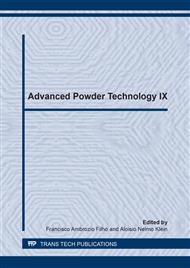p.483
p.491
p.496
p.501
p.507
p.512
p.518
p.524
p.530
Chemical, Structural and Mechanical Study of Metallic Biomaterials Used in Hip Arthroplasty
Abstract:
Arthroplasty is a surgery that aims to replace the defective joint surfaces, aiming to restore their functions. Is employed in this type of surgery that metallic materials play a key role in the constitution of orthopedic prostheses. In this context, we studied the chemical composition, mechanical and structural behavior of stainless steel developed for applications as biomaterials used in the manufacture of orthopedic implants. In this paper, two prostheses were analyzed established brands in the market. Proceeded through the chemical Spectroscopy Energy Dispersive X-ray (EDX) analysis. Characterized the crystal structures of these materials by diffraction of X-ray and mechanical behavior using tensile test. We compared the results of chemical composition and strength of the samples according to ASTM F-138 (2008). The results of EDX showed the presence of chloride in stainless steel alloys as an impurity that can compromise the durability of the prosthesis. The XRD patterns showed the presence in austenitic stainless steel alloys. As the tensile strength of the alloys analyzed, values that are consistent with those presented in the standards were recorded. In a general analysis, it became apparent incompatibility of assessed as biomaterials for use in prosthetic alloys, although meets the structural and mechanical requirements.
Info:
Periodical:
Pages:
507-511
Citation:
Online since:
December 2014
Keywords:
Price:
Сopyright:
© 2014 Trans Tech Publications Ltd. All Rights Reserved
Share:
Citation:


